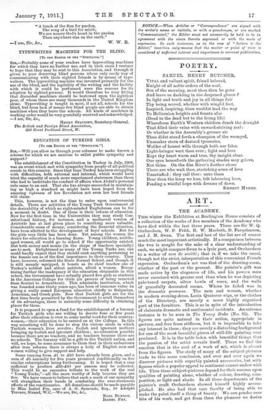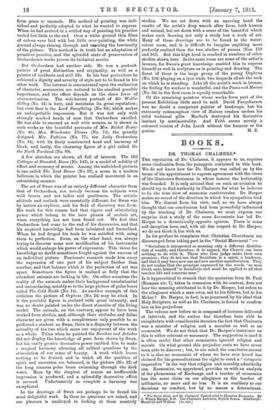ART.
THE ACADEMY.
Tins winter the Exhibition at Burlington House consists of a collection of the works of five members of the Academy who have died within the last three years. These are Sir W. Q. Orchardson, W. P. Frith, R. W. Macbeth, D. Farquharson, and J. M. Swan. The first and last of the list are of course much the most important artistically. If a comparison between the two is sought for the sake of a clear understanding of each, we might compare Swan to a lyric poet, and Orchardson to a writer of vers de socigte ; that is, if we take the usual, though not the strict, interpretation of this convenient French expression. Orchardson's art was that of the drawing-room, whether of the past or the present. His painter's gift was made active by the elegances of life, and his powers were never exercised with greater zest than when he was depicting pale-toned carpets, silver bowls of roses, and the walls of gracefully decorated rooms. Where he failed was in the dramatis personae. The men and women, whether in modern evening-dress, Louis Quatome wigs, or the clothes of the Directory, are merely a more highly organised part of the furniture. This is so in spite of the introduction of elaborate dramatic and sentimental incidents. An extreme instance is to be seen in The Young Duke (No. 85). The figures are quite natural in their action, appropriate in gesture, and free from stiffness, but it is impossible to take any interest in them ; they are merely a disturbing background for one of the most beautiful pieces of still-life painting ever produced. It is in the table laden with beautiful things that the passion of the artist reveals itself. There we find the emotion that is the soul of a work of art, which is absent from the figures. The study of many of the subject-pictures leads to this same conclusion, and over and over again we discover pictures with superbly painted accessories, but with figures which a popular appeal to sentiment cannot endow with life. Thus these subject-pictures depend for their success upon qualities of painting alone, whether of colour, drawing, com- position, or light and shade. In all these departments of the painter's craft Orchardson showed himself highly accom- plished. He also had that rare faculty of being able to make the paint itself a thing of beauty. We can ponder over bits of his work, and get from them the pleasure we derive
from gems enamels. His method of painting was indi- vidual and perfectly adapted to what he wanted to express. When he had arrived at a settled way of painting his practice varied but little to the end. Over a white ground thin films of colour were laid with but little over-painting, the white ground always shining through and ()wring the luminosity of the picture. This method is in truth but an adaptation of primitive practice, and the splendid state of preservation of Orchardson's works proves its technical merits.
But Orchardson had another side. He was a portrait- painter of great distinction and originality, as well as a painter of incidents and still life. In his best portraiture he achieved a dignity and severity of style not to be found in his other work. The interest is concentrated upon the realisation of character, accessories are reduced to the smallest possible importance, and the effect depends on the sheer force of characterisation. The well-known portrait of Sir Walter Gilbey (No. 61) is here, and maintains its great reputation ; but even finer is the Lord Swaythting (No. 64), which makes an unforgettable impression. But it was not only with strongly marked heads of men that Orchardson excelled. He was able to succeed as well with women, as is shown in such works as the beautiful portraits of Mrs. Birket Foster (No. 40), Mrs. Winchester Clowes (No. 74), the grandly designed Mrs. Pattison (No. 77), the Lady Orchardson (No. 84), with its finely constructed head and harmony of black, and lastly, the charming figure of a girl called On the North Foreland (No. 89).
A few sketches are shown, all full of interest. The Old Cottages at Stansted, Buss (No. 143), is a model of solidity of effect and economy of means. Among the unfinished pictures is one called The Last Dance (No. 93), a scene in a modern ballroom in which the painter has realised movement in an astonishing manner.
The art of Swan was of an entirely different character from that of Orchardson, not merely because his subjects were wild beasts and not ladies and gentlemen. The artistic attitude and outlook were essentially different, for Swan was by nature an explorer, and his field of discovery was form. His work for this reason had that vigour and stimulating power which belong to the later phases of archaic art, when everything has not been found out. We feel that Orchardson had come to the end of his discoveries, and that his acquired knowledge had been tabulated and formalised. When he had forged his tools he was satisfied with using them to perfection. Swan, on the other hand, was always trying to discover some new modification of his instrument which would enlarge his power of expression. This thirst for knowledge no doubt sometimes fought against the success of an individual picture. Passionate research made him carry the expression of one part of his subject further than another, and that balance which is the perfection of art was upset. Sometimes the figure is realised so fully that the attendant animals are lacking in life. On other occasions the reality of the animals makes their background unsubstantial and unconvincing, notably so in the large picture of polar bears called The Cold North (No. 14). As another example of this criticism the picture of Orpheus (No. 24) may be cited. In it the youthful figure is realised with great intensity, and was no doubt painted under the direct stimulus of the living model. The animals, on the contrary, appear to have been worked from studies, and, although their attitudes and feline character are given with a completeness only possible to so profound a student as Swan, there is a disparity between the actuality of the two which mans our enjoyment of the work as a whole. Titian when he painted the Bacchus and Ariadne did not display the knowledge of pure form shown by Swan, but his vastly greater decorative power enabled him to make a magical harmony silencing all critical questions by the stimulation of our sense of beauty. A work which leaves nothing to be desired, and in which all the qualities of spirit and execution are balanced, is the picture (No. 22) of the long sinuous polar bears swimming through the dark water. Here by the simplest of means an ineffaceable impression is produced, and a splendidly decorative effect is secured. Unfortunately so complete a harmony was exceptional.
ID the drawings of Swan are perhaps to be found his most delightful work. In_them no questions are raised, and our pleasure is nnalloyesil in looking 4 these masterly
studies. We see set down with an unerring hand the results of the artist's deep search after form, both human and animal, but set down with a sense of the beautiful which makes each drawing not only a study but a work of art. Many of these drawings are to be found in the water- colour room, and it is difficult to imagine anything more perfectly realised than the two studies of pumas (Nos. 159 and 163). But this high level is reached in numbers of other studies shown here. In the same room are some of the artist's bronzes, for Swan's great knowledge enabled him to express himself as well in sculpture as in painting and drawing. The finest of these is the large group of the young Orpheus (No. 194) playing on a lyre while two leopards climb the rock on which he is standing. Like all the artist's work in bronze, the feeling for surface is wonderful, and the Puma and Macaw (No. 34) in the first room is equally remarkable.
Of the remaining painters whose works form part of the present Exhibition little need be said. David Farquharson was no doubt a competent painter of landscape, but his extremely commonplace view of Nature renders useless his solid technical gifts. Macbeth destroyed his decorative instinct by sentimentality. And Frith seems merely a coloured version of John Leech without the humour or the



















































 Previous page
Previous page